List of United States Democratic Party presidential tickets
From Wikipedia, the free encyclopedia
This is a list of American electoral candidates for the offices of President of the United States and Vice President of the United States of the modern Democratic Party, either duly preselected and nominated, or the presumptive nominees of a future preselection and election. Opponents who received over one percent of the popular vote or ran an official campaign that received Electoral College votes are listed. Offices held prior to Election Day are included, and those held on Election Day have an italicized end date.
19th century[edit]
1828, 1832[edit]
1836, 1840[edit]
| Presidential nominee |
1836 (won), 1840 (lost) | Vice presidential nominee |
|
|---|---|---|---|
| Martin Van Buren of NY (1782–1862) 
|
|
|
Richard Johnson of KY (1780–1850) 
|
| Opponent(s) William Harrison (Northern Whig) Hugh White (Southern Whig) |
|
Opponent(s) Francis Granger (Northern Whig) John Tyler (Southern Whig) |
|
| Opponent(s) William Harrison (Whig) |
|
Opponent(s) John Tyler (Whig) |
|
1844[edit]
1848[edit]
1852[edit]
1856[edit]
1860[edit]
1864[edit]
1868[edit]
1872[edit]
1876[edit]
1880[edit]
1884, 1888, 1892[edit]
| Presidential nominee |
1884 (won), 1888 (lost), 1892 (won) | Vice presidential nominee |
|
|---|---|---|---|
| Grover Cleveland of NY (1837–1908) 
|
|
|
Thomas Hendricks of IN (1819–1885) 
|
|
Allen Thurman of OH (1813–1895) 
|
||
|
Adlai Stevenson of IL (1835–1914) 
|
||
| Opponent(s) James Blaine (Republican) St. John (Prohibition) Benjamin Butler (Greenback) |
|
Opponent(s) John Logan (Republican) William Daniel (Prohibition) Absolom West (Greenback) |
|
| Opponent(s) Benjamin Harrison (Republican) Clinton Fisk (Prohibition) Alson Streeter (Union Labor) |
|
Opponent(s) Levi Morton (Republican) John Brooks (Prohibition) Charles Cunningham (Union Labor) |
|
| Opponent(s) Benjamin Harrison (Republican) James Weaver (Populist) John Bidwell (Prohibition) |
|
Opponent(s) Whitelaw Reid (Republican) James Field (Populist) James Cranfill (Prohibition) |
|
1896, 1900[edit]
| Presidential nominee |
1896 (lost), 1900 (lost) | Vice presidential nominee |
|
|---|---|---|---|
| William Jennings Bryan of NE (1860–1925) 
|
|
|
Arthur Sewall of ME (1835–1900) 
|
|
Adlai Stevenson of IL (1835–1914) 
|
||
| Opponent(s) William McKinley (Republican) |
|
Opponent(s) Garret Hobart (Republican) Thomas E. Watson (Populist) |
|
| Opponent(s) William McKinley (Republican) John Woolley (Prohibition) |
|
Opponent(s) Theodore Roosevelt (Republican) Henry Metcalf (Prohibition) |
|
20th century[edit]
1904[edit]
1908[edit]
1912, 1916[edit]
| Presidential nominee |
1912 (won), 1916 (won) | Vice presidential nominee |
|
|---|---|---|---|
| Woodrow Wilson of NJ (1856–1924) 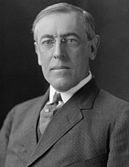
|
|
|
Thomas Marshall of IN (1854–1925) 
|
| Opponent(s) William Taft (Republican) Theodore Roosevelt (Progressive) Gene Debs (Socialist) Eugene Chafin (Prohibition) |
|
Opponent(s) Nicholas Butler (Republican) Hiram Johnson (Progressive) Emil Seidel (Socialist) Aaron Watkins (Prohibition) |
|
| Opponent(s) Charles Hughes (Republican) Allan Benson (Socialist) Frank Hanly (Prohibition) |
|
Opponent(s) Charles Fairbanks (Republican) Kirk Kirkpatrick (Socialist) Ira Landrith (Prohibition) |
|
1920[edit]
1924[edit]
1928[edit]
1932, 1936, 1940, 1944[edit]
| Presidential nominee |
1932 (won), 1936 (won), 1940 (won), 1944 (won) | Vice presidential nominee |
|
|---|---|---|---|
| Franklin D. Roosevelt of NY (1882–1945) 
|
|
|
Jack Garner of TX (1868–1967) 
|
|
Henry Wallace of IA (1888–1965) 
|
||
|
Harry S. Truman of MO (1884–1972) 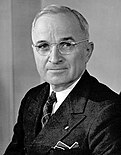
|
||
| Opponent(s) Herbert Hoover (Republican) Norman Thomas (Socialist) |
|
Opponent(s) Charles Curtis (Republican) James Maurer (Socialist) |
|
| Opponent(s) Alf Landon (Republican) William Lemke (Union) |
|
Opponent(s) Frank Knox (Republican) Thomas O’Brien (Union) |
|
| Opponent(s) Wendell Willkie (Republican) |
|
Opponent(s) Charles L. McNary (Republican) |
|
| Opponent(s) Thomas Dewey (Republican) |
|
Opponent(s) John Bricker (Republican) |
|
1948[edit]
| Presidential nominee |
1948 (won) | Vice presidential nominee |
|
|---|---|---|---|
| Harry S. Truman of MO (1884–1972) 
|
|
|
Alben Barkley of KY (1877–1956) 
|
| Opponent(s) Thomas Dewey (Republican) Strom Thurmond (Dixiecrat) Henry Wallace (Progressive) |
|
Opponent(s) Earl Warren (Republican) Fielding Wright (Dixiecrat) Glen Taylor (Progressive) |
|
1952, 1956[edit]
| Presidential nominee |
1952 (lost), 1956 (lost) | Vice presidential nominee |
|
|---|---|---|---|
| Adlai Stevenson II of IL (1900–1965) 
|
|
|
John Sparkman of AL (1899–1985) 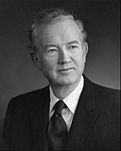
|
|
Estes Kefauver of TN (1903–1963) 
|
||
| Opponent(s) Dwight D. Eisenhower (Republican) |
|
Opponent(s) Richard Nixon (Republican) |
|
|
|||
1960[edit]
1964[edit]
1968[edit]
1972[edit]
1976, 1980[edit]
| Presidential nominee |
1976 (won), 1980 (lost) | Vice presidential nominee |
|
|---|---|---|---|
| Jimmy Carter of GA (born 1924) 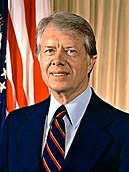
|
|
|
Walter Mondale of MN (1928–2021) 
|
| Opponent(s) Gerald Ford (Republican) |
|
Opponent(s) Bob Dole (Republican) |
|
| Opponent(s) Ronald Reagan (Republican) John B. Anderson (Independent) Ed Clark (Libertarian) |
|
Opponent(s) George H. W. Bush (Republican) Patrick Lucey (Independent) David Koch (Libertarian) |
|
1984[edit]
1988[edit]
1992, 1996[edit]
| Presidential nominee |
1992 (won), 1996 (won) | Vice presidential nominee |
|
|---|---|---|---|
| Bill Clinton of AR (born 1946) 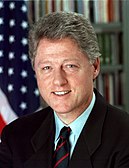
|
|
|
Al Gore of TN (born 1948) 
|
| Opponent(s) George H. W. Bush (Republican) Ross Perot (Independent) |
|
Opponent(s) Dan Quayle (Republican) James Stockdale (Independent) |
|
| Opponent(s) Bob Dole (Republican) Ross Perot (Reform) |
|
Opponent(s) Jack Kemp (Republican) Pat Choate (Reform) |
|
21st century[edit]
2000[edit]
2004[edit]
2008, 2012[edit]
| Presidential nominee |
2008 (won), 2012 (won) | Vice presidential nominee |
|
|---|---|---|---|
| Barack Obama of IL (born 1961) 
|
|
|
Joe Biden of DE (born 1942) 
|
| Opponent(s) John McCain (Republican) |
|
Opponent(s) Sarah Palin (Republican) |
|
| Opponent(s) Mitt Romney (Republican) |
|
Opponent(s) Paul Ryan (Republican) |
|
2016[edit]
| Presidential nominee |
2016 (lost) | Vice presidential nominee |
|
|---|---|---|---|
| Hillary Clinton of NY (born 1947) 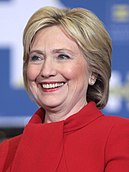
|
|
|
Tim Kaine of VA (born 1958) 
|
| Opponent(s) Donald Trump (Republican) Gary Johnson (Libertarian) Jill Stein (Green) |
|
Opponent(s) Mike Pence (Republican) Bill Weld (Libertarian) Ajamu Baraka (Green) |
|
2020[edit]
| Presidential nominee |
2020 (won) | Vice presidential nominee |
|
|---|---|---|---|
| Joe Biden of DE (born 1942) 
|
|
|
Kamala Harris of CA (born 1964) 
|
| Opponent(s) Donald Trump (Republican) Jo Jorgensen (Libertarian) |
|
Opponent(s) Mike Pence (Republican) Spike Cohen (Libertarian) |
|
See also[edit]
- ^ If not for unpledged electors, Rush would have won 178 (68.2%) votes.
- ^ South Carolina’s delegates were selected by the state legislature and not by popular vote, which went to the Nullifier ticket of Floyd/Lee, which did not campaign, while 30 Pennsylvania delegates voted Wilkins for Vice President. Two Maryland delegates did not cast votes.
- ^ The Whig Party ran regional candidates in 1836. William H. Harrison and Francis Granger ran in Northern states, while Hugh Lawson White and John Tyler ran in Southern states. Daniel Webster was on the ballot in Massachusetts and Willie Person Mangum received votes from the Electoral College without being on the ballot.
- ^ Wright declined after being nominated by the convention.
- ^ Douglas and Johnson were chosen at the national nominating convention after most of the Southern delegations walked out, who held a separate national nominating convention to nominate Breckinridge and Lane.
- ^ If not for 17 invalidated electors from Union-occupied Louisiana and Tennessee, Lincoln and Johnson would have won 229 (91.6%) votes.
- ^ If not for 17 invalidated electors from Union-occupied Louisiana and Tennessee, McClellan and Pendleton would have won 8.4% of the votes.
- ^ If not for the 14 invalidated electors from voting irregularities in Arkansas and Louisiana, Grant and Wilson would have won 300 (82.0%) votes.
- ^ Greeley died after the election but before the Electoral College convened, and was not replaced for the vote. The ticket’s intended delegates were scattered.
- ^ If not for the 14 invalidated electors for Grant and Wilson from voting irregularities in Arkansas and Louisiana, Greeley and Brown’s 66 votes would have been 18.0%.
- ^ If not for a faithless elector, Eisenhower and Nixon would have won 458 (86.3%) in 1956.
- ^ Eagleton withdrew from the ticket and was replaced by Shriver.
- ^ a b If not for a faithless elector, Nixon and Agnew would have won 521 (96.8%) Electoral College votes.
- ^ If not for a faithless elector, Ford would have won 241 (44.8%) votes.
- ^ a b A faithless elector swapped their votes for President and Vice President in the Electoral College, otherwise the Dukakis/Bentsen ticket would have won 112 (20.8%) votes.
- ^ An elector from the District of Columbia abstained from casting a vote for the Gore/Lieberman ticket, otherwise Gore would have won 267 (49.6%) votes.
- ^ A faithless elector voted Edwards for President and Vice President in the Electoral College, otherwise Kerry would have won 252 (46.8%) votes.
- ^ If not for faithless electors, Trump and Pence would have won 306 (56.9%) Electoral College votes each, while Clinton and Kaine would have won 232 (43.1%) votes.

Our servers are currently under maintenance or experiencing a technical problem.
Please try again in a few minutes.
See the error message at the bottom of this page for more information.
Recent Comments